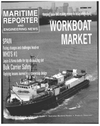
Page 82: of Maritime Reporter Magazine (October 1997)
Read this page in Pdf, Flash or Html5 edition of October 1997 Maritime Reporter Magazine
RESEARCH & DEVELOPMENT — FUEL QUALITY e your business
UNITED
TECHNOLOGIES
CARRIER TMfJSSCOLD which are part of the WG, present- ed statistical data based on many thousand HFO samples, which had been analyzed for the presence of
ULO.
The conclusion was: —The presence of ULO in marine fuel is very low. —ULO in HFO is most frequently found in North American bunkers. —ULO in HFO contributes to a few cases of failing, if it is to meet the ISO 8217 ash limits.
A second question is, what risks are involved when waste lube oil is mixed into HFO?
From the WG discussions it was obvious that no one has proved what concentration of ULO are required to harm the engine and the exhaust gas system. However, if seen in terms of service experi- ence, it is agreed that metal com-
It's a decision that keeps passengers comfortable wherever you sail.
It's an experienced supplier who's more like a business partner. as well as your investment. ©1995 Carrier Transicold
Circle 234 on Reader Service Card
The sun sets on another memorable day. Another day enjoyed with Carrier
Transicold air conditioning and refrig- eration. Another sunset preserved by a green refrigerant. Reliability and responsibility are why more and more cruise lines value Carrier. Balance is the nature of your business.
It's zero-ODP Refrigerant-134a, to protect the environment.
Value is a full line of high-performance chillers and condensing systems.
It's service and parts support dedicated to the marine industry.
Performance that protects the earth
TRANSICOLD 90CM Marine Centrifugal Chiller (l,700kW) pounds from a ULO will contribute to an increase in the ash level, and thereby the wear rates of the engine components, and lead to the possibility of further deposits form- ing and fouling that combustion zone and exhaust gas system.
However, the total ash level, as concluded by the major fuel testing services survey, is only in a few cases higher than the maximum ash content specified in ISO 8172 and CIMAC-H55.
With regard to separator efficien- cy, as a function of ULO amount, the results of an investigation car- ried out by one WG member showed the analytical data, obtained by testing fuel oil blends with three percent, six percent and 15 percent of ULO before and after a separator.
The differences observed in respect to the efficiency of the sep- arator removing water, catalytic fines and ash from high and low density residual fuels blended with the above-stained amounts of
ULO, were very small.
The opinion of the engine builders concerning the effect on the engine, when blending waste lube oil into HFO, is not consis- tent.
Fuel suppliers are also divided on this issue as some see no prob- lems with adding up to five per- cent waste lube oil, while others prefer to recommend the use of
HFO without any waste lube oil added.
The WG has not yet reached a final conclusion with regard to
ULO. However, the main body has so far emerged of the opinion as follows: —Waste, which is not lube oil, must not be mixed with the HFO due to safety considerations. —The fuel supplier should inform his customers about any sub- stances added to the HFO. —The concept of adding ULO to
HFO can influence the engine component wear rates and fouling of the gas ways. —The higher ash level, due to added ULO, will influence the con- tent of particulate in the exhaust gas emission.
Kjeld Aabo, Chairman CIMAC
Heavy Fuel Working Group
MAN B&W Diesel A/S
Wanda Fabriek, Secretary of

 81
81

 83
83
